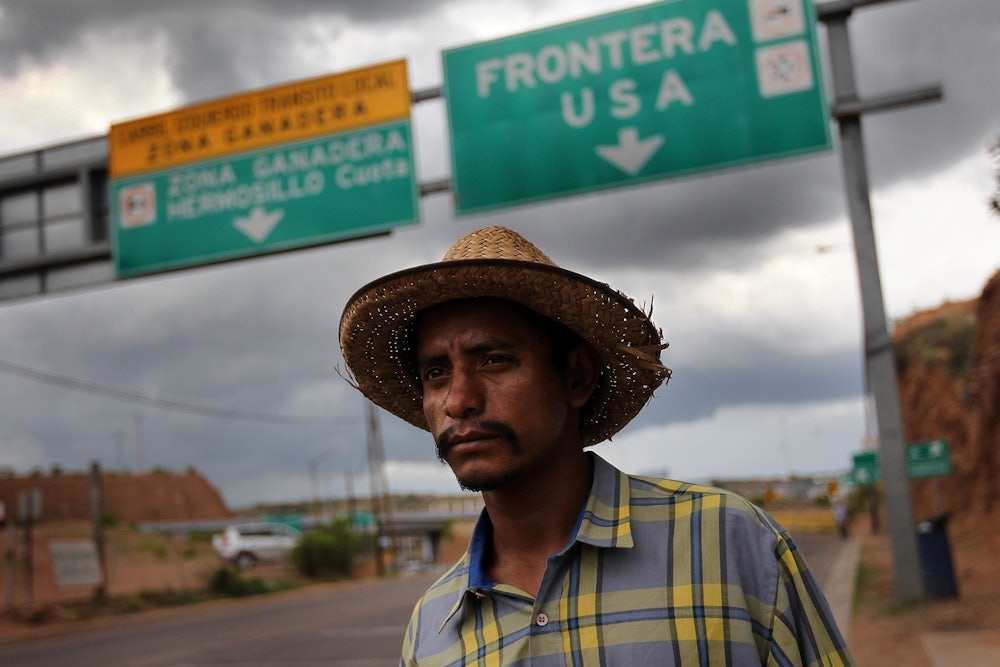Every four years in the United States, a common refrain is heard: “If candidate X wins the White House, I’m moving to Canada.” In 2000, facing the prospect of a President George W. Bush, Eddie Vedder of Pearl Jam memorably vowed, “I’m moving to a different country if little Damien II is elected.” Vedder didn’t keep his word, but Pierre Salinger, former press secretary to John F. Kennedy, did, expatriating himself to France, where he died in 2004.
Most people are more like Vedder than Salinger—quick to make idle threats of relocation but slow to act on them. According to an Ipsos poll conducted in March, 19 percent of Americans would consider moving to Canada if Donald Trump is elected (a slightly smaller number, 15 percent, said they were pondering emigration if Hillary Clinton prevails). The truth is, though, even the most upsetting election result will never be enough to inspire a substantial number of Americans to pull up their stakes and plant them in a foreign land. And despite his gobsmacking success in the Republican primaries, few liberals still take Trump’s policy proposals—or his prospects for winning—seriously enough to be house hunting in Toronto or Winnipeg.
But if there is one thing Trump is dead serious about, it’s mass deportation. If he is elected president, our emigration problem will not involve well-to-do liberals leaving voluntarily, but millions of undocumented Americans being forcibly expelled. Trump has offered an actual plan for dealing with undocumented immigrants—broad in outline, clear in intent. He’s been unwavering on what he intends to do: Deport the approximately 11 million undocumented immigrants in America, construct a wall along the Mexican border, and block remittance payments sent by undocumented immigrants back to Mexico in order to force the Mexican government to pay for that wall. And he has cited a genuinely scary historical precedent. On multiple occasions, Trump has praised President Dwight Eisenhower’s mass deportation effort—although he’s been careful not to mention its name, which was based on a slur used to refer to Mexican migrants who would swim the Rio Grande to cross over into Texas: Operation Wetback.
“Let me just tell you that Dwight Eisenhower—a good president, great president,” Trump said in a November GOP debate. “People liked him. ‘I like Ike.’ ... Moved a million and a half illegal immigrants out of this country, moved them just beyond the border: They came back. Moved them again, beyond the border: They came back. ... Moved them way south. They never came back.”
It won’t surprise any Trump-watcher that he got the details of Operation Wetback wrong. Far from a success on any score, it was a blot on America’s reputation, a program that turned immigration control into a refugee crisis. Operation Wetback is all too well-known to Hispanics, a crucial and cautionary part of their history in the United States. But it’s long been largely, and conveniently, forgotten by the rest of American society. That makes the episode well worth revisiting, given that the leading Republican contender for president is vowing to replicate it—only on a much vaster scale.

The roots of Operation Wetback can be traced to the birth of large-scale farming in the Southwest. Prior to the 1920s, agriculture in the United States centered on family farms, with the work done by sharecroppers who lived nearby. But in that decade, a new type of farm emerged in California, Arizona, and Texas—owned by banks, lawyers, and investors, and worked by a migrant class that moved from state to state and across the Mexico-U.S. border. Without this reserve army of cheap labor, large-scale, proto-corporate farming would have been so unprofitable as to be virtually impossible. The migrant workers’ lack of political rights was a key part of the system, since it kept labor organizing to a minimum.
In 1942, the Mexican and American governments tried to bring order to this exploitive system by agreeing to the Bracero Program (formally known as the Migrant Labor Agreement), which permitted vetted contract laborers (mainly screened for health problems) to be legal guest workers for a fixed term, usually a few months at a time. Braceros were promised fair treatment in wages and boarding, but enforcement was lax and employer abuse was widespread.
The Bracero Program was meant to be an alternative to undocumented immigration, but ended up providing a cover for it. Though there were between 200,000 and 450,000 braceros per year in the 1950s, farmers wanted more laborers—and the existence of a large number of braceros created communities where undocumented workers could also find work. And as large farms employed braceros, smaller farmers often turned to the undocumented to stay competitive. If braceros were shadow workers with nebulous rights, the hundreds of thousands of undocumented workers who came in the wake of the program existed as shadows of shadows.
Operation Wetback, initiated in 1954 and overseen by President Eisenhower’s military pal, retired Major General Joseph M. Swing, had an ostensibly humanitarian rationale; social groups like churches and labor unions had been raising alarms about the exploitation of immigrant labor. But the most influential push came from farming interests who had created the problem. For them, it was a way to shut down proposed laws that would penalize them for hiring undocumented workers.
Cold war paranoia also fueled Operation Wetback. In 1954, Teamster Magazine complained that “more than 100 Communists a day are coming across the sparsely patrolled border.” Eisenhower’s attorney general, Herbert Brownell Jr., tried to shoot those rumors down, noting that while it was theoretically possible there might have been subversives crossing the border, there was absolutely “no evidence” of it. A similar lack of evidence has not, of course, stopped Trump from articulating the twenty-first-century equivalent of that conspiracy theory, peddling rumors of terrorists crossing the Southern border. “Tens of thousands,” he wildly claimed in December, bearing “cell phones with isis flags on them.”
The model for Trump’s immigration “solution” was a humanitarian catastrophe. Operation Wetback led to a drastic militarization of the border, with the Immigration and Naturalization Service using jeeps and planes to swoop up migrants. Over one million people were reportedly sent back to Mexico in 1954, and a further 242,000 the following year. The methods of removal were cruel: More than a quarter of the migrants were taken in cargo ships from Port Isabel, Texas, to Veracruz, Mexico—a form of transportation that a congressional investigation would later compare to an “eighteenth-century slave ship” and a “penal hell ship.” Others were simply dumped deep in the interior—or, in Trump’s words, “way south.”
One labor official told historian Mae N. Ngai about a horrific but hardly unique incident, in which “some 88 braceros died of sunstroke as a result of a roundup that had taken place in 112-degree heat, and … more would have died had Red Cross not intervened.” According to the same labor official, “Literally hundreds of thousands of braceros were roaming about the streets” of Mexicali, a border town just opposite Calexico. And because the category of “wetback” was not a clear legal one but rather a racial slur, it was easy for it to extend far beyond the parameters of the undocumented; an unknown number of American citizens who didn’t have proper documents were swept up.
By citing Operation Wetback as a model, Trump has given us a chilling foretaste of what he means to do. Just as in the Eisenhower era, he would give a free pass to the business leaders who employ undocumented workers (a wise move, in a purely self-serving sense, since Trump himself falls into that camp). The brunt of the policy would fall on the most vulnerable, and the effect would be to degrade an entire ethnic group. While Trump hasn’t deigned to say how he’d go about rounding up and removing millions of people, his version of Eisenhower’s program would undoubtedly cause massive collateral damage. The undocumented are woven deeply into the fabric of existing American society. Going after them would tear apart families and whole communities.
Trump may cut a ridiculous figure, but we can’t afford to shrug off his promise to revive Operation Wetback. It’s his signature issue, after all, the one that catapulted him into front-runner status in the GOP primary—and the one that will get much of the credit (and blame) if he manages to win the White House. As outlandish as the idea of deporting 11 million people sounds, as president, Trump could work within existing law to accomplish much of the goal through executive action. Beyond that, a newly elected Trump would have a mandate to push Congress for draconian immigration laws.
Under President Trump, we could fully expect to relive one of the most shameful episodes in American history. Which is no reason to be thinking of packing up and leaving the country—but plenty of incentive for any fair-minded American to stay and fight.
